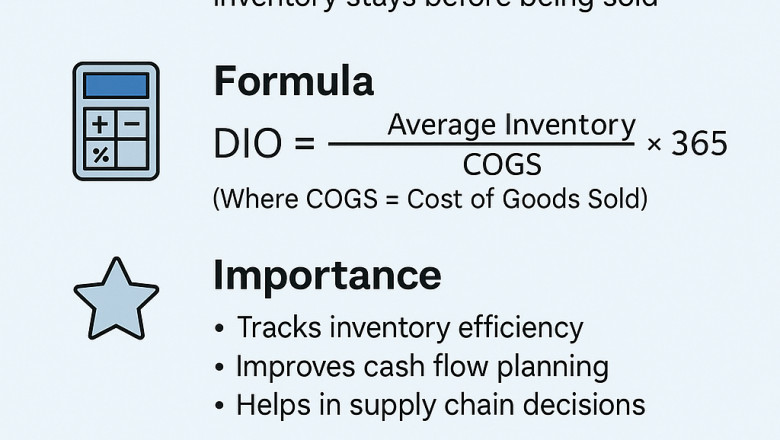views
What is DIO and Why It Matters
Days Inventory Outstanding (DIO) refers to the number of days on average a business keeps its inventory before selling it. This is a very important metric for cash flow, operational efficiency as well as profitability. In other words, Days in Inventory (also known as Days Sales in Inventory—DSI—or simply, DIO) tells you how fast your products are moving, and therefore, how many days' worth of sales inventory you may have tied up.
DIO Meaning and Formula
Using the formula you can calculate DIO.
DIO = (Average Inventory ÷ Cost of Goods Sold) × 365
Where:
-
Average Inventory = (Beginning Inventory + Ending Inventory) ÷ 2
-
COGS = Cost of Goods Sold for the period
This is how to calculate the average number of days’ inventory is on hand before it’s sold.
Example Calculation
For example, if you have beginning inventory of $50,000, ending inventory of $70,000 and COGS is $300,000.
Average Inventory = (50,000 + 70,000) ÷ 2 = $60,000
DIO = (60,000 ÷ 300,000) × 365 = 73 days
In other words, your inventory on average takes 73 days to sell.
What’s a Good DIO?
There’s no universal “perfect” DIO. It depends on your industry:
-
Retail or groceries: 7–30 days
-
Apparel: 30–60 days
-
Manufacturing: 90–120+ days
Fast Sales is usually a good thing to have, but too low a DIO could result in stockouts. Over stocking or poor demand could be indicated by a high DIO.
Why DIO is Crucial
-
Inventory lying too long ties up cash. Lower DIO = more liquidity.
-
It helps to find slow-moving stock or over purchasing.
-
Free delivery: Helps in better purchasing decisions and forecasting decisions.
-
Inventory Turnover vs. DIO
-
Inventory Turnover = COGS ÷ Average Inventory
-
DIO = 365 ÷ Inventory Turnover
-
The two are closely related one gives you how often inventory turns and other tells you how long it takes to turn.
How to Improve Your DIO
-
Use accurate demand forecasting
-
Adopt Just-in-Time (JIT) inventory systems
-
Improve supplier lead times
-
Analyze slow-moving products
-
Common Mistakes with DIO
-
Comparing across different industries
-
Ignoring seasonality
-
Refusing to enhance the number of choices being currently offered
Best Tools to Track DIO
Real time automation and monitoring of DIO using modern tools like QuickBooks Commerce, Zoho Inventory, NetSuite, or SAP based inventory and accounting tools.
Conclusion
DIO is more than just a number, it’s a great data point into how your business is performing when it comes to getting inventory into cash and it can be positive or negative. If you can keep it in check, you’ll be more profitable, leaner, and your finances will be in better control.
FAQs
1. Is a lower DIO always better?
Stockouts can also result from too low, but not always.
2. How often should I check DIO?
Monthly or quarterly, depending on your sales volume.
3. Can DIO help reduce costs?
It’s true that lesser storage time will lower the carrying costs.
4. What are the two main ways to program the microcontrollers?
However, for whatever reason, they have different names, but they mean the same thing.
5. What tools help track DIO?
ERP and inventory software like NetSuite or QuickBooks Commerce.
Visit us: accountinglads.com














Comments
0 comment